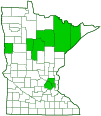dogwood spittlebug
(Clastoptera proteus)
Conservation • Description • Habitat • Ecology • Distribution • Taxonomy
|
|
||||||||||||||
Description |
Dogwood spittlebug is a small, highly variable but easily recognized, jumping insect. It occurs in the United States from Maine to Minnesota, south to North Carolina and eastern Texas, and in southern Canada from Nova Scotia to Manitoba. It is adventive in the west in Washington, Idaho, western Montana, and southern Vancouver Canada. Nymphs feed on the sap of at least five species of dogwood shrubs. They have no exoskeleton and produce a spittle mass in order to remain moist. Adults feed on the foliage of those same dogwoods, and also on blueberries and buckeyes. Females are ⅛″ (3.3 to 4.1 mm) in length. Males are a little smaller, ⅛″ (2.9 to 3.5 mm) in length. The body is yellow and black, short, and almost globe shaped. The face is directed downward and is not visible when viewed from the front and a little above. The antennae are short and bristle-like. The plate over the thorax (pronotum) does not extend back over the abdomen. The plate behind the pronotum (scutellum) is elongated. There is a convex false eyespot on each side of the thorax near the wing base, and another at the rear near each wing tip. The legs are yellow. On the fourth segment (tibia) of the hind leg, the outer edge has two stout, thorn-like spurs, and there is a circlet of black-tipped spines at the tip. The lower half of the face is entirely yellow and contrasts strongly with the entirely black upper half. The head and the front half of the pronotum are marked with contrasting black and yellow bands. Beyond this, the amount of each color is highly variable. The false eyespots may be black or brownish-orange. The forewings are usually mostly black with a patch of yellow near the base and a patch of brownish-orange at the rear. Nymphs resemble adults but they are pale, and they have no wings. They usually have a pale yellowish abdomen and a dark head and thorax. Sometimes they are light brown with dark brown at the base and the tip of the abdomen. |
Size |
Female: ⅛″ (3.3 to 4.1 mm) Male: ⅛″(2.9 to 3.5 mm) |
Similar Species |
Habitat |
|
Ecology |
Season |
May through August |
Behavior |
|
Life Cycle |
Eggs are laid under bark in the summer and overwinter. |
Nymph Food |
Sap of dogwoods |
Adult Food |
Foliage of dogwoods, blueberries, and buckeyes |
Distribution |
||
|
Sources |
|
| 11/13/2024 | ||
Occurrence |
||
|
||
Taxonomy |
|
Order |
Hemiptera (True bugs, Hoppers, Aphids, and Allies) |
Suborder |
Auchenorrhyncha (true hoppers) |
Infraorder |
Cicadomorpha (spittlebugs, cicadas, leafhoppers and treehoppers) |
Superfamily |
Cercopoidea (spittlebugs and froghoppers) |
Family |
Clastopteridae |
Subfamily |
Clastopterinae |
Tribe |
Clastopterini |
Genus |
Clastoptera |
Subordinate Taxa |
|
This is a highly variable species, and ten subspecies have been described, but these are not recognized by most sources. |
|
Clastoptera proteus anceps Clastoptera proteus candens Clastoptera proteus flava Clastoptera proteus hyperici Clastoptera proteus nigra Clastoptera proteus nigricollis Clastoptera proteus osceola Clastoptera proteus proteus Clastoptera proteus seminuda Clastoptera proteus vittata |
|
Synonyms |
|
Cercopis proteus Clastopetera proteus |
|
Common Names |
|
dogwood spittlebug |
|
Glossary
Pronotum
The exoskeletal plate on the upper side of the first segment of the thorax of an insect.
Scutellum
The exoskeletal plate covering the rearward (posterior) part of the middle segment of the thorax in some insects. In Coleoptera, Hemiptera, and Homoptera, the dorsal, often triangular plate behind the pronotum and between the bases of the front wings. In Diptera, the exoskeletal plate between the abdomen and the thorax.
Tibia
The fourth segment of an insect leg, after the femur and before the tarsus (foot). The fifth segment of a spider leg or palp. Plural: tibiae.
Visitor Photos |
||
Share your photo of this insect. |
||
This button not working for you? |
||
Alfredo Colon |
||
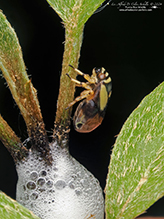 |
||
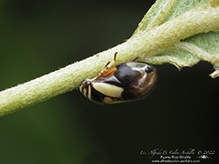 |
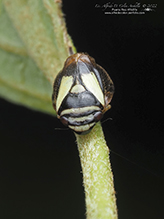 |
|
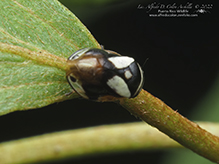 |
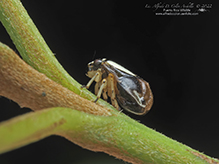 |
|
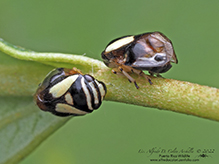 |
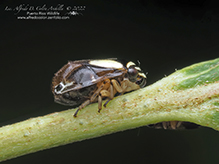 |
|
Babette Kis |
||
Clastoptera proteus dogwood spittlebug |
||
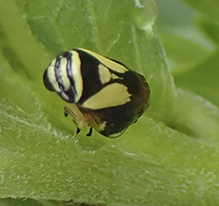 |
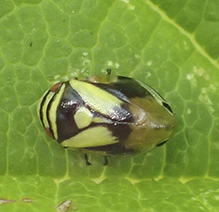 |
|
Dogwood spittlebug on gray dogwood leaf Barnes Prairie Racine Co., WI July 31, 2020 |
Dogwood spittlebug on Queen of the prairie, Barnes Prairie, Racine Co., WI July 2, 2022 |
|
MinnesotaSeasons.com Photos |
||
|
||
|

Slideshows |
|

Visitor Videos |
||
Share your video of this insect. |
||
This button not working for you? |
||
|
Other Videos |
||
Dogwood Spittlebug Nymphs |
About
May 27, 2019 Dogwood Spittlebug, Clastoptera proteus, wiped clean and trying to rebuild its bubble cover. |

Visitor Sightings |
||
Report a sighting of this insect. |
||
This button not working for you? |
||
Alfredo Colon |
Location: Albany, NY |
 |
| Alfredo Colon 8/8/2022 |
Location: Albany, NY |
 |
| Alfredo Colon 8/7/2022 |
Location: Albany, NY |
 |
| Alfredo Colon 8/4/2022 |
Location: Albany, NY |
 |
| Babette Kis 7/31/2022 |
Location: Barnes Prairie, Racine Co., WI Dogwood spittlebug on gray dogwood leaf Barnes Prairie Racine Co., WI July 31, 2020 |
 |
| Babette Kis 7/2/2022 |
Location: Barnes Prairie, Racine Co., WI Dogwood spittlebug on Queen of the prairie, Barnes Prairie, Racine Co., WI July 2, 2022 |
 |
MinnesotaSeasons.com Sightings |
||
|

Created: 1/4/2023 Last Updated: © MinnesotaSeasons.com. All rights reserved. |
